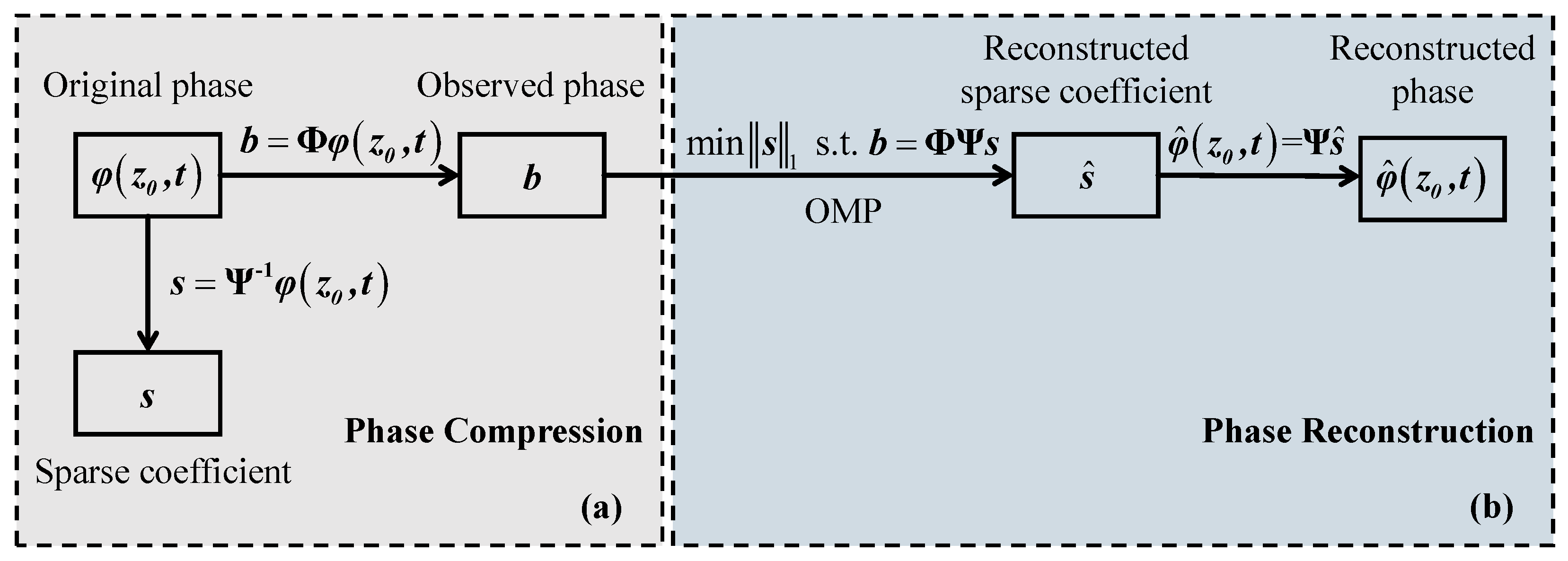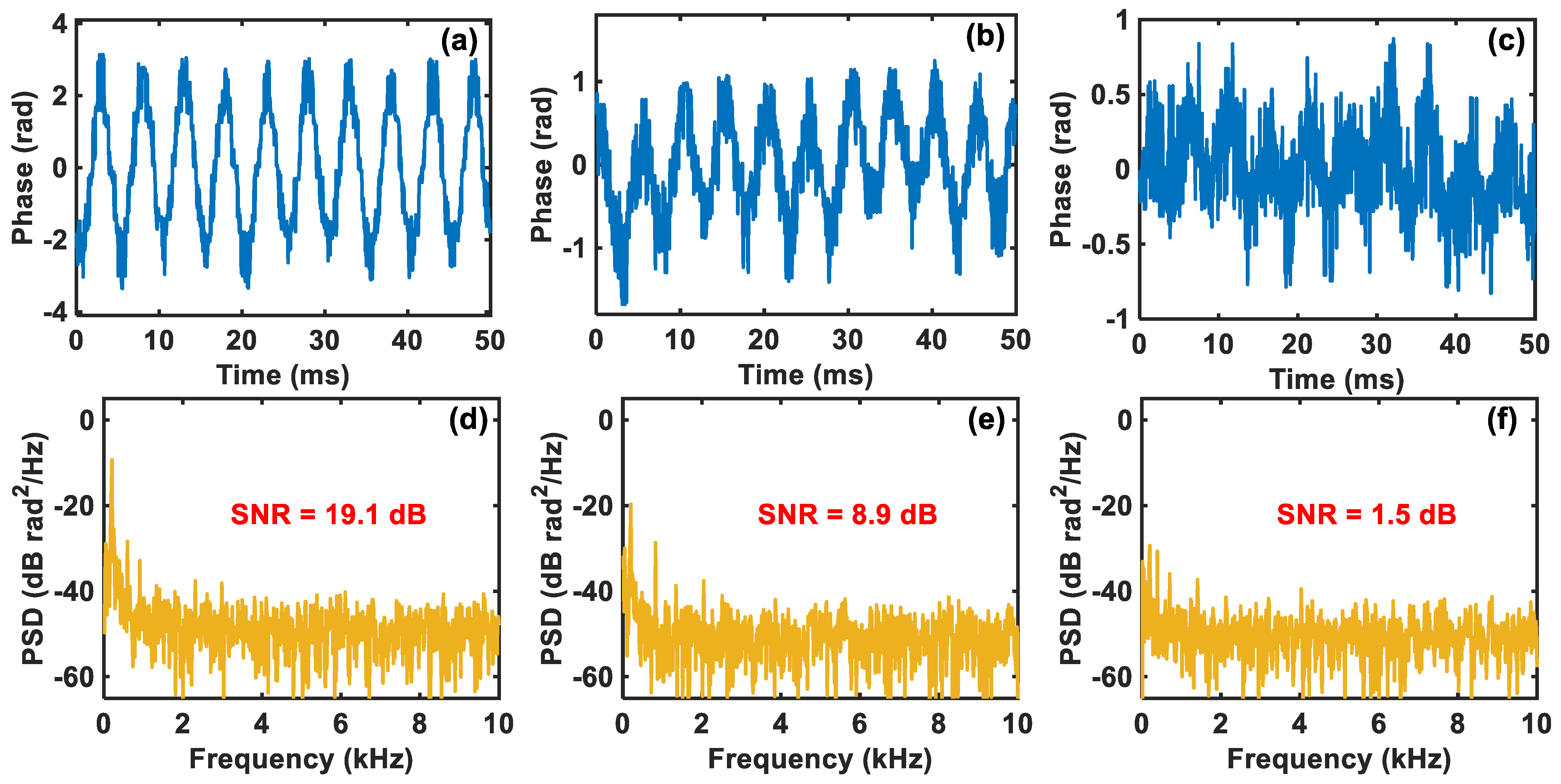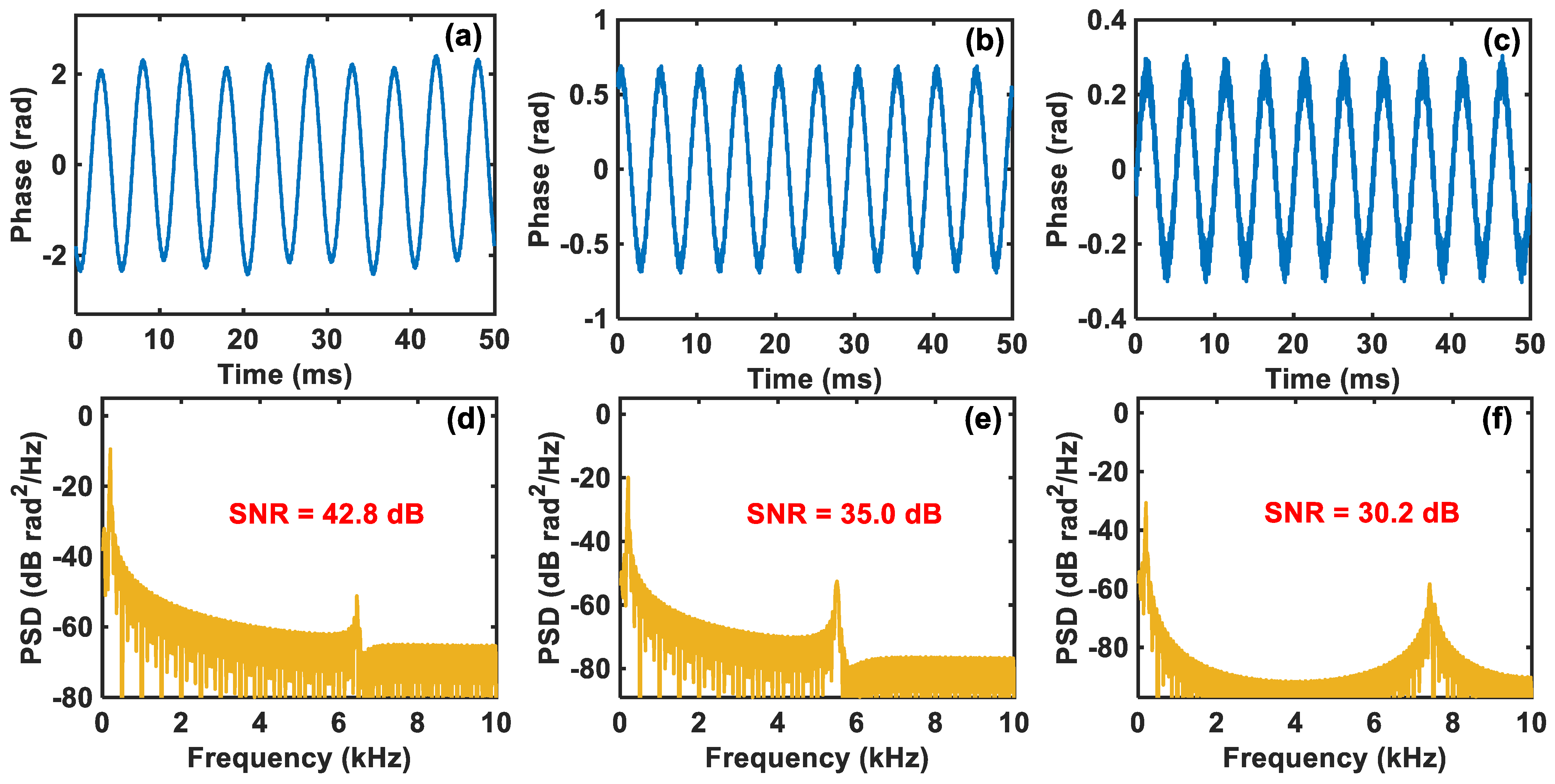SNR Enhancement for Comparator-Based Ultra-Low-Sampling Φ-OTDR System Using Compressed Sensing
Abstract
1. Introduction
2. Principles and Theoretical Analysis
2.1. Principle of Comparator-Based Ultra-Low-Sampling Φ-OTDR System
2.2. Theory of Phase Reconstruction Using Compressed Sensing
3. Experimental Setup and Results
3.1. Experimental Setup
3.2. Results of Comparator-Based Ultra-Low-Sampling Φ-OTDR System
3.3. Analysis of Compressed Sensing Results
4. Conclusions
Author Contributions
Funding
Institutional Review Board Statement
Informed Consent Statement
Data Availability Statement
Acknowledgments
Conflicts of Interest
References
- Barrias, A.; Casas, J.; Villalba, S. A Review of Distributed Optical Fiber Sensors for Civil Engineering Applications. Sensors 2016, 16, 748. [Google Scholar] [CrossRef] [PubMed]
- Wijaya, H.; Rajeev, P.; Gad, E. Distributed optical fibre sensor for infrastructure monitoring: Field applications. Opt. Fiber Technol. 2021, 64, 102577. [Google Scholar] [CrossRef]
- Wu, H.; Chen, J.; Liu, X.; Xiao, Y.; Wang, M.; Zheng, Y.; Rao, Y. One-Dimensional CNN-Based Intelligent Recognition of Vibrations in Pipeline Monitoring With DAS. J. Light. Technol. 2019, 37, 4359–4366. [Google Scholar] [CrossRef]
- Stajanca, P.; Chruscicki, S.; Homann, T.; Seifert, S.; Schmidt, D.; Habib, A. Detection of Leak-Induced Pipeline Vibrations Using Fiber-Optic Distributed Acoustic Sensing. Sensors 2018, 18, 2841. [Google Scholar] [CrossRef] [PubMed]
- Dou, S.; Lindsey, N.; Wagner, A.M.; Daley, T.M.; Freifeld, B.; Robertson, M.; Peterson, J.; Ulrich, C.; Martin, E.R.; Ajo-Franklin, J.B. Distributed Acoustic Sensing for Seismic Monitoring of The Near Surface: A Traffic-Noise Interferometry Case Study. Sci. Rep. 2017, 7, 11620. [Google Scholar] [CrossRef] [PubMed]
- Fernandez-Ruiz, M.R.; Martins, H.F.; Williams, E.F.; Becerril, C.; Magalhaes, R.; Costa, L.; Martin-Lopez, S.; Jia, Z.; Zhan, Z.; Gonzalez-Herraez, M. Seismic Monitoring with Distributed Acoustic Sensing from the Near-Surface to the Deep Oceans. J. Light. Technol. 2022, 40, 1453–1463. [Google Scholar] [CrossRef]
- Xiao, Z.Y.; Yuan, X.G.; Zhang, Y.A.; Xu, S.Y.; Li, Z.Y.; Huang, Y.Q. Frequency Response Enhancement of Φ-OTDR Using Interval-Sweeping Pulse Equivalent Sampling Based on Compressed Sensing. J. Light. Technol. 2023, 41, 768–776. [Google Scholar] [CrossRef]
- Tu, G.; Zhang, X.; Zhang, Y.; Zhu, F.; Xia, L.; Nakarmi, B. The Development of an Φ-OTDR System for Quantitative Vibration Measurement. IEEE Photon. Technol. Lett. 2015, 27, 1349–1352. [Google Scholar] [CrossRef]
- Masoudi, A.; Belal, M.; Newson, T.P. A distributed optical fibre dynamic strain sensor based on phase-OTDR. Meas. Sci. Technol. 2013, 24, 85201–85204. [Google Scholar] [CrossRef]
- Fang, G.; Xu, T.; Feng, S.; Li, F. Phase-Sensitive Optical Time Domain Reflectometer Based on Phase-Generated Carrier Algorithm. J. Lightwave Technol. 2015, 33, 2811–2816. [Google Scholar] [CrossRef]
- Jiang, J.; Wang, Z.; Wang, Z.; Wu, Y.; Lin, S.; Xiong, J.; Chen, Y.; Rao, Y. Coherent Kramers-Kronig Receiver for Φ-OTDR. J. Light. Technol. 2019, 37, 4799–4807. [Google Scholar] [CrossRef]
- Lu, Y.; Zhu, T.; Chen, L.; Bao, X. Distributed Vibration Sensor Based on Coherent Detection of Phase-OTDR. J. Light. Technol. 2010, 28, 3243–3249. [Google Scholar]
- Wang, Z.; Zhang, L.; Wang, S.; Xue, N.; Peng, F.; Fan, M.; Sun, W.; Qian, X.; Rao, J.; Rao, Y. Coherent Φ-OTDR based on I/Q demodulation and homodyne detection. Opt. Express 2016, 24, 853–858. [Google Scholar] [CrossRef] [PubMed]
- Fu, Y.; Xue, N.; Wang, Z.; Zhang, B.; Xiong, J.; Rao, Y. Impact of I/Q Amplitude Imbalance on Coherent Φ-OTDR. J. Light. Technol. 2018, 36, 1069–1075. [Google Scholar] [CrossRef]
- Lv, L.; Pang, F.; Liu, H.; Mei, X.; Chen, J.; Li, Y.; Song, Y.; Wang, T. 50-km-long distributed vibration fiber sensor based on phase-sensitive OTDR using coherent detection. In Proceedings of the Conference on Lasers and Electro-Optics Pacific Rim (CLEO-PR), Singapore, 31 July–4 August 2017. [Google Scholar]
- Pan, Z.; Liang, K.; Ye, Q.; Cai, H.; Qu, R.; Fang, Z. Phase-sensitive OTDR system based on digital coherent detection. In Proceedings of the Asia Communications and Photonics Conference and Exhibition (ACP), Shanghai, China, 13–16 November 2011. [Google Scholar]
- Liu, S.; Shao, L.; Yu, F.H.; Lin, W.; Xiao, D.; Sun, S.; Li, S.; Hang, P.S.; Un, M.P.; Vai, M.I. Accelerating the phase demodulation process for heterodyne Φ-OTDR using spatial phase shifting. Opt. Lett. 2023, 48, 1048–1051. [Google Scholar] [CrossRef]
- Wang, P.; Xu, N.; Wang, Y.; Liu, X.; Gao, Y.; Jin, B.; Zhang, H. Multiresolution Phase Compensation for Phase-Sensitive OTDR. IEEE Sens. J. 2022, 22, 14937–14943. [Google Scholar] [CrossRef]
- Liehr, S.; Muanenda, Y.S.; Munzenberger, S.; Krebber, K. Relative change measurement of physical quantities using dual-wavelength coherent OTDR. Opt. Express 2017, 25, 720–729. [Google Scholar] [CrossRef] [PubMed]
- Chen, D.; Liu, Q.; He, Z. Phase-detection distributed fiber-optic vibration sensor without fading-noise based on time-gated digital OFDR. Opt. Express 2017, 25, 8315–8325. [Google Scholar] [CrossRef]
- Chen, X.; Zou, N.; Liang, L.; He, R.; Liu, J.; Zheng, Y.; Wang, F.; Zhang, X.; Zhang, Y. Submarine cable monitoring system based on enhanced COTDR with simultaneous loss measurement and vibration monitoring ability. Opt. Express 2021, 29, 13115–13128. [Google Scholar] [CrossRef]
- Fan, C.; Li, H.; Zhang, K.; Liu, H.; Sun, Y.; Liu, H.; Yan, B.; Yan, Z.; Liu, D.; Shum, P.P.; et al. 300 km ultralong fiber optic DAS system based on optimally designed bidirectional EDFA relays. Photon. Res. 2023, 11, 968–977. [Google Scholar] [CrossRef]
- Wu, H.; Zhou, B.; Zhu, K.; Shang, C.; Tam, H.; Lu, C. Pattern recognition in distributed fiber-optic acoustic sensor using an intensity and phase stacked convolutional neural network with data augmentation. Opt. Express 2021, 29, 3269–3283. [Google Scholar] [CrossRef] [PubMed]
- Jiang, F.; Li, H.; Zhang, Z.; Hu, Z.; Hu, Y.; Zhang, Y.; Zhang, X. Undersampling for fiber distributed acoustic sensing based on coherent phase-OTDR. Opt. Lett. 2019, 44, 911–914. [Google Scholar] [CrossRef]
- Yu, F.H.; Liu, S.; Shao, L.; Xu, W.; Xiao, D.; Zhao, F.; Hu, J.; Lin, W.; Wang, G.; Wang, W.; et al. Ultra-low sampling resolution technique for heterodyne phase-OTDR based distributed acoustic sensing. Opt. Lett. 2022, 47, 3379–3382. [Google Scholar] [CrossRef] [PubMed]
- Yu, F.; Shao, L.; Liu, S.; Xu, W.; Xiao, D.; Liu, H.; Shum, P.P. Data Reduction in Phase-Sensitive OTDR with Ultra-Low Sampling Resolution and Undersampling Techniques. Sensors 2022, 22, 6386. [Google Scholar] [CrossRef] [PubMed]
- Reiss, J.D. Understanding Sigma-Delta Modulation: The Solved and Unsolved Issues. J. Audio Eng. Soc. 2008, 56, 49–64. [Google Scholar]
- Bakopoulos, P.; Dris, S.; Schrenk, B.; Lazarou, I.; Avramopoulos, H. Bandpass sampling in heterodyne receivers for coherent optical access networks. Opt. Express 2012, 20, 29404–29412. [Google Scholar] [CrossRef] [PubMed]
- Koyamada, Y.; Imahama, M.; Kubota, K.; Hogari, K. Fiber-Optic Distributed Strain and Temperature Sensing with Very High Measurand Resolution Over Long Range Using Coherent OTDR. J. Light. Technol. 2009, 27, 1142–1146. [Google Scholar] [CrossRef]
- Healey, P. Fading in heterodyne OTDR. Electron. Lett. 1984, 20, 30–32. [Google Scholar] [CrossRef]
- Xu, N.; Wang, P.; Wang, Y.; Liu, X.; Bai, Q.; Gao, Y.; Zhang, H.; Jin, B. Crosstalk Noise Suppressed for Multi-frequency ϕ-OTDR Using Compressed Sensing. J. Light. Technol. 2021, 39, 7343–7350. [Google Scholar] [CrossRef]
- Qu, S.; Chang, J.; Cong, Z.; Chen, H.; Qin, Z. Data compression and SNR enhancement with compressive sensing method in phase-sensitive OTDR. Opt. Commun. 2019, 433, 97–103. [Google Scholar] [CrossRef]
- Rauhut, H.; Schnass, K.; Vandergheynst, P. Compressed Sensing and Redundant Dictionaries. IEEE Trans. Inf. Theory 2008, 54, 2210–2219. [Google Scholar] [CrossRef]
- Candes, E.J.; Wakin, M.B. An Introduction to Compressive Sampling. IEEE Signal Process. Mag. 2008, 25, 21–30. [Google Scholar] [CrossRef]
- Tropp, J.A.; Gilbert, A.C. Signal Recovery from Random Measurements Via Orthogonal Matching Pursuit. IEEE Trans. Inf. Theory 2007, 53, 4655–4666. [Google Scholar] [CrossRef]
- Shen, X.; Wu, H.; Zhu, K.; Liu, H.; Li, Y.; Zheng, H.; Li, J.; Shao, L.; Shum, P.P.; Lu, C. Fast and Storage-Optimized Compressed Domain Vibration Detection and Classification for Distributed Acoustic Sensing. J. Light. Technol. 2024, 42, 493–499. [Google Scholar] [CrossRef]
- Chen, D.; Liu, Q.; Fan, X.; He, Z. Distributed Fiber-Optic Acoustic Sensor with Enhanced Response Bandwidth and High Signal-to-Noise Ratio. J. Light. Technol. 2017, 35, 2037–2043. [Google Scholar] [CrossRef]







Disclaimer/Publisher’s Note: The statements, opinions and data contained in all publications are solely those of the individual author(s) and contributor(s) and not of MDPI and/or the editor(s). MDPI and/or the editor(s) disclaim responsibility for any injury to people or property resulting from any ideas, methods, instructions or products referred to in the content. |
© 2024 by the authors. Licensee MDPI, Basel, Switzerland. This article is an open access article distributed under the terms and conditions of the Creative Commons Attribution (CC BY) license (https://creativecommons.org/licenses/by/4.0/).
Share and Cite
Xiao, Z.; Li, X.; Zhang, H.; Yuan, X.; Zhang, Y.-A.; Zhang, Y.; Li, Z.; Wang, Q.; Huang, Y. SNR Enhancement for Comparator-Based Ultra-Low-Sampling Φ-OTDR System Using Compressed Sensing. Sensors 2024, 24, 3279. https://doi.org/10.3390/s24113279
Xiao Z, Li X, Zhang H, Yuan X, Zhang Y-A, Zhang Y, Li Z, Wang Q, Huang Y. SNR Enhancement for Comparator-Based Ultra-Low-Sampling Φ-OTDR System Using Compressed Sensing. Sensors. 2024; 24(11):3279. https://doi.org/10.3390/s24113279
Chicago/Turabian StyleXiao, Zhenyu, Xiaoming Li, Haofei Zhang, Xueguang Yuan, Yang-An Zhang, Yuan Zhang, Zhengyang Li, Qi Wang, and Yongqing Huang. 2024. "SNR Enhancement for Comparator-Based Ultra-Low-Sampling Φ-OTDR System Using Compressed Sensing" Sensors 24, no. 11: 3279. https://doi.org/10.3390/s24113279
APA StyleXiao, Z., Li, X., Zhang, H., Yuan, X., Zhang, Y.-A., Zhang, Y., Li, Z., Wang, Q., & Huang, Y. (2024). SNR Enhancement for Comparator-Based Ultra-Low-Sampling Φ-OTDR System Using Compressed Sensing. Sensors, 24(11), 3279. https://doi.org/10.3390/s24113279





